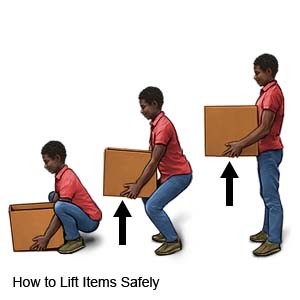Proper Body Mechanics
Medically reviewed by Drugs.com. Last updated on Apr 6, 2025.
What are proper body mechanics?
Body mechanics are the way you move during daily activities. Proper body mechanics can help you avoid injury and muscle fatigue.
What proper body mechanics guidelines do I need to follow?
- Bend at your hips and knees instead of your waist. This helps you maintain your balance by dividing your weight evenly between your upper and lower body.
- Spread your feet apart to create a foundation of support. This helps you maintain your balance from side to side.
- Keep your back, neck, pelvis, and feet aligned when you turn or move. Do not twist or bend at your waist.
How do I practice proper body mechanics?
- When you stand:
- Keep your feet flat on the floor about 12 inches (30 cm) apart.
- Do not lock your knees.
- Keep your shoulders down, chest out, and back straight.
- When you lift an object:
- Your feet should be apart, with one foot slightly in front of the other.
- Keep your back straight.
- Bend from your hips and knees.
- Do not bend at your waist.
- Lift the object using your arm and leg muscles.
- Hold the object close to your body at your waist level.
- Use the same process if you need to push or pull something heavy.

- When you sit:
- Sit with your back straight and place extra support behind your lower back.
- Get up and change positions often if you sit for long periods of time.
- Ask about exercises to stretch your neck and shoulders.
- Adjust your computer so the top of the monitor is at the same level as your eyes.
- Use a paper holder so that the document is at the same level as the computer screen.
- Use a headset if you use the telephone often.
What else do I need to know about proper body mechanics?
- Wear shoes with low heels, closed backs, and nonslip soles. This will help prevent falling and improve your body alignment.
- Push rather than pull objects. It is easier to push than to pull.
- Ask for help or use an available device for assistance. Assistive or mechanical devices help decrease your risk for injury.
Care Agreement
You have the right to help plan your care. Learn about your health condition and how it may be treated. Discuss treatment options with your healthcare providers to decide what care you want to receive. You always have the right to refuse treatment. The above information is an educational aid only. It is not intended as medical advice for individual conditions or treatments. Talk to your doctor, nurse or pharmacist before following any medical regimen to see if it is safe and effective for you.© Copyright Merative 2025 Information is for End User's use only and may not be sold, redistributed or otherwise used for commercial purposes.
Further information
Always consult your healthcare provider to ensure the information displayed on this page applies to your personal circumstances.
